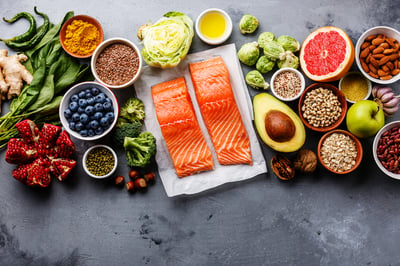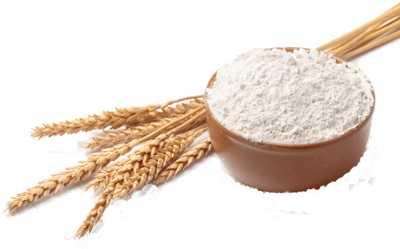
Do you ever find it difficult to determine if your favorite foods are actually healthy for you?
Between misleading labels and the never-ending supply of ‘healthy’ foods on every supermarket shelf, eating healthy can be a confusing and even daunting task.
If you’re between the ages of 35 and 50, the choices you make regarding your health right now are more important than ever. In fact, the choices you make today can help support a healthy you now, and in the future.
Take a look below as we explore ‘healthy foods’ and provide some insight into whether the foods in your diet are providing you with the nutrients you need.
What is Considered “Healthy Food”?
While eating fads come and go, there are a few key elements to healthy eating that remain unchanged.
Here is what we know:
"Healthy Food” Defined
 Healthy foods are those that provide you with the nutrients you need to sustain your body’s well-being and retain energy. Water, carbohydrates, fat, protein, vitamins, and minerals are the key nutrients that make up a healthy, balanced diet.
Healthy foods are those that provide you with the nutrients you need to sustain your body’s well-being and retain energy. Water, carbohydrates, fat, protein, vitamins, and minerals are the key nutrients that make up a healthy, balanced diet.
Facts You Should Know:
- Only 1 in 10 adults meet the daily recommendation for fruit and vegetable intake
- Fruits and Vegetable Serving Sizes
This information tells us we need to focus on eating fresh foods that provide us with the nutrients our bodies need.
Unfortunately, the food industry doesn’t make as much of a profit on fresh foods; processed foods are where the money's at. Even big food companies have lobbied aggressively against public health plans - such as a campaign ordering the removal of junk food from schools.
These junk food items, processed from crops such as corn, wheat, and soybeans, are high in calories (fillers) and lack the nutritional value your body needs. However, because they are derived from crops, it can be difficult to know if they are healthy or not, and misleading claims on labels only make things worse.
How to Read Food Labels
According to a recent Nielsen report, almost 60-percent of consumers misinterpret or have a hard time comprehending nutrition labels.
One of the most critical parts of reading your food labels is to look at the serving size; 160 calories may not seem like much, but that could be for only two little cookies. Continue reading for other factors to keep in mind when grocery shopping for your healthy foods.
Saying “zero trans fat”, “all natural”, or “contains whole wheat” can trick you into thinking the product is healthy, even when its nutritional value has been stripped away after being processed.

Alternatively, many packaged products are packed with salt, sugar, and saturated fat. In other words, these claims make you forget about the added calories. Here is a list of what you should know before you read your food’s nutritional facts:
- Sugar: Women should try to limit their sugar intake to 25 g / day or 6 teaspoons
- Fat: There are about 9 calories per gram of fat - stick to about 50 g / day
- Sodium: Women should not consume more than 1,500 mg or 3.8 g of salt / day
- Protein: Women exercising less than 30 min / day should eat about 46 g of protein / day
- Vitamins: Naturally occurring vitamins are ideal, but added vitamins can be helpful too
- Calories: The average amount for women is 2,000 / day and 1,500 / day to lose weight based on a 150 lb. woman
As women between the ages of 35 and 50, not knowing what is good or bad for your body can create unwarranted stress. Use the following as a resource to ease the worries that come along with taking the right steps to strengthen your future health.
What Should Women Eat to Stay Healthy?
A healthy eating plan is one that encompasses all of the nutrients your body needs on a daily basis without any non-nutritional additives.
A healthy, balanced diet includes:
- Vegetables and any subgroup such as beans, peas, starches, and those that are dark green, red or orange in color
- Whole fruits
- Whole grains such as quinoa, corn, millet, and brown rice
- Limited full-fat dairy
- A variety of protein such as lean meats, eggs, nuts, seeds, and soy products
- Oils such as olive, flaxseed, canola, and avocado
Only about one-fourth of the population is eating the recommended amounts of fruit, vegetables, dairy, and oils. However, over half of the population are meeting or going beyond the total grains and protein recommendations.
When consuming grains, it’s encouraged to only eat whole grains that include the entire grain kernel, bran, and germ. If you are eating refined grains (or processed grains), the bran and germ have been removed which takes out the iron, dietary fiber, and other key nutrients.
How healthy do you think your lifestyle is? Take this short quiz to find out!
Are Fats Healthy?
YES
Not all fats are bad for you! You may have already heard that avocados are high in fat, but it’s good fat! Avocados, canola oil, and nuts all contain monounsaturated or polyunsaturated fats.
Your body needs these good fats as an important source of energy. These fats also help absorb certain vitamins and minerals, build cell membranes, and are essential for blood clotting, reducing inflammation, and muscle movement.
NO
Saturated and trans fats are the kind of fats you should stay away from as much as possible. These are the worst kinds of fat for your body and come from the hydrogenation process that solidifies healthy oils to prevent them from going bad.
Trans fats are common in baked goods that have been made with partially hydrogenated vegetable oil, fried foods, chips, creamer, and margarine.
Common foods that contain saturated fats include cheese, coconut oil, whole milk, and red meat.
Eating foods with high trans fat and saturated fats can cause inflammation or artery blockages which can lead to chronic conditions such as diabetes and heart disease, or even a stroke.
What About Carbs, Are They Healthy?
YES
Well, they can be. Eaten in moderation, carbohydrates can be a healthy tool to help your body get valuable nutrients. Too much of any food, however, can lead to weight gain.
Carbs (or any foods) with limited or minimal processing are the healthiest choices. For instance, whole grain bread is a healthier choice than refined white bread.
Other healthy carbohydrates that can also help boost your mood, promote weight loss, and lower LDL cholesterol include:
- Legumes (lentils, edamame, chickpeas, peas, etc.)
- Grains (corn, barley, oats, brown rice, etc.)
- Vegetables (spinach, broccoli, mushrooms, cauliflower, etc.)
NO
Determining which carbs are good or bad can sometimes be difficult. The easiest way to tell if food is processed is to ask yourself ‘Can this product be found in nature?’
If not, you know it’s processed. Chips, cookies, pasta, ice cream, etc., don’t exist in nature, but instead have been altered and refined from whole grains and ultimately become forms of sugars and starches. Another easy way to tell is if it comes from a box - if so, you probably don’t have to eat it.
Women’s Vitamins for Preventative Health
It’s recommended that your vitamins include the following nutrients or that you incorporate these nutrients into your daily diet:
- Calcium: A higher calcium diet may help women lower the risk of osteoporosis.
- Iron: With each menstrual cycle, women are losing iron. For women that are premenopausal, the Recommended Dietary Allowance (RDA) is 18 mg of iron a day
- Omega-3 fatty acids: As women age, their estrogen levels decline which can put them at a higher risk of developing heart disease. These fatty acids can act as an anti-inflammatory for your body.
Most doctors would agree that getting antioxidants and vitamins from the foods you eat is the best way to get your daily dose in, but talk to your women’s preventative health specialist to see if supplements are the way to go for you.
“Healthy Foods” That Are Actually Bad For You and Why
You may be surprised to learn that some “healthy” foods are not very healthy at all.
Microwave popcorn
Packaged popcorn can have high levels of a chemical called diacetyl and not to mention the unnecessary sodium. Stick to the old-fashioned style and pop your kernels on the stove.
Light salad dressing
Although the label may say “light”, the ingredient list on light salad dressing is still packed full of preservatives, sodium, and sugars. It’s best to try substituting your dressings with extra virgin olive oil or balsamic vinegar.
Trail mix
Prepackaged or not, a “yummy” trail mix is going to be filled with salt and sugars from flavored nuts and chocolate. Read the labels carefully, a small handful could be as much as 300 calories!
Flavored, fat-free yogurt
Although it may be fat-free, the additives in flavored fat-free yogurt should have you second-guessing this choice. From just one 6-ounce serving, there could be 15 grams of sugar. As an alternative, garnish a fat-free Greek yogurt with fresh fruit or honey.
Spinach pasta
If you’re looking for a way to get your greens in, pasta isn’t the way to do it. After processing, there’s little to no spinach actually left in spinach pasta and hardly any nutritional value.
Low-fat / fat-free foods
Low-fat foods have the fat reduced during the manufacturing process. But removing the fat also removes the flavor. To boost the flavor, low-fat foods are often packed with added sugar and salt. As such, reaching for low-fat foods is not as healthy as you might think.
Wheat bread
Bread that is actually healthy for you will say “100% whole wheat” as well as have at least two grams of fiber per slice. If the bread doesn’t say it’s completely whole wheat, there’s a chance the majority of the bread is white flour with just enough wheat flour to pass with looks.
will say “100% whole wheat” as well as have at least two grams of fiber per slice. If the bread doesn’t say it’s completely whole wheat, there’s a chance the majority of the bread is white flour with just enough wheat flour to pass with looks.
Gluten-free products
Having the label “gluten-free” doesn’t automatically mean a product is healthy. Instead, stick to naturally gluten-free foods such as fruits, vegetables, and brown rice.
Frozen dinners
Although the idea of having portioned veggies, meats and grains made up for you sounds like an easy way to be healthy, it really isn’t. Compared to fresh foods, fruits, and vegetables, frozen meals contain preservatives and often, too much sodium.
Pretzels
They might seem like the perfect, healthy, “fat-free” snack on-the-go, but pretzels actually have close to zero nutritional value. Once eaten, pretzels spike your blood sugar levels and leave you hungry for more.
Veggie chips
Veggie chips are not really vegetables at all. In fact, after all of the processing that the vegetables are put through, almost all of the nutritional value from them is no longer present. If you’re looking for a crunchy snack, try roasting some of your favorite vegetables.
Protein bars
Although the word “protein” is included in the name, that’s not a reason to deem any food healthy. Most protein bars are only a few calories and grams of sugar away from being categorized as a candy bar.
Organic foods
Organic foods are free from pesticides, antibiotics, and most additives, but that doesn’t mean organic snack foods aren’t being processed and filled with just as much sugar as non-organic snack foods.
Smoothies
Using fresh fruit, veggies and nutrient-based additives, such as flaxseed, smoothies can be a great way to make a healthy breakfast smoothie. However, this isn’t how they’re usually made outside of your own kitchen. Artificially flavored powder, extra sugar, and even ice cream are sometimes used. So think twice about drinking premade smoothies from the store or juice stand.
Flavored soy milk
Not to be confused with plain soy milk - which has both potassium and protein and even low cholesterol - chocolate and vanilla flavored soy milk have plenty of sugar and calories and act more like a dessert than a healthy snack or drink to fill you up.
Coffee
You may not realize it, but your everyday pick-me-up might be the hidden calorie offender. Simple modifications can do wonders to your overall health, such as choosing sugar-free syrup, a smaller serving size, and skim milk instead of whole milk.
Alcohol
Although drinking a glass of wine a day can reduce the risk of stroke and heart disease, and tequila - for example - can help with digestion, alcohol actually has about seven calories per gram.
Common Themes In Unhealthy Foods
The words “processed”, “calories”, and “sugar” should now be triggers for you as you continue your search for unhealthy foods that disguise themselves as healthy.
Lowering your sugar intake will not only help you maintain a healthy weight, but it can also reduce the risk of some cancers, reduce the amount of blood sugar level spikes (which can be what’s causing your energy and mood swings), and can also lead you to have less significant menopause symptoms.
How Your Doctor Can Help You
Why it’s important to include your doctor in your nutrition and overall health
Talking with your doctor about your overall health and your dietary concerns is always a good idea. At Moreland OB-GYN, our team of women’s health doctors believes in guiding and treating you with a holistic approach as we consider your stressors, your lifestyle, and even the foods you eat.
What you should bring to your appointment
It’s important to come to your appointments prepared to ensure you and your doctor have the best chance of having a productive discussion. Here is a list of what you should consider bringing the next time you meet with your doctor.
- A list of medications or alternative therapies. Have a list ready-to-go or just bring in your medication or vitamin bottles themselves.
- A symptom journal. If you are seeing your doctor for a specific issue you are experiencing, write down your symptoms. Include the time of day and other factors that may contribute such as what you ate that day, any big events, or stressors going on at the time.
- Questions for your doctor. Although questions may come up on the spot, it can be very helpful to take some time before your appointment to think about questions you might have. Write them down and let your doctor know when you get there that you have questions to ask at the end of your session together.
As a woman approaching the perimenopausal and menopausal phase of your life, it’s important to be mindful of how the decisions you make today can impact your future health.
Don’t forget to read your labels carefully and keep in mind that the healthiest choices don’t have a list of ingredients!
At Moreland OB-GYN, we specialize in women’s preventive health care and prioritizing the needs of our patients. We hope you’ll connect with us to help answer your questions and we hope you’ll turn to our experts as a trusted resource for information.












